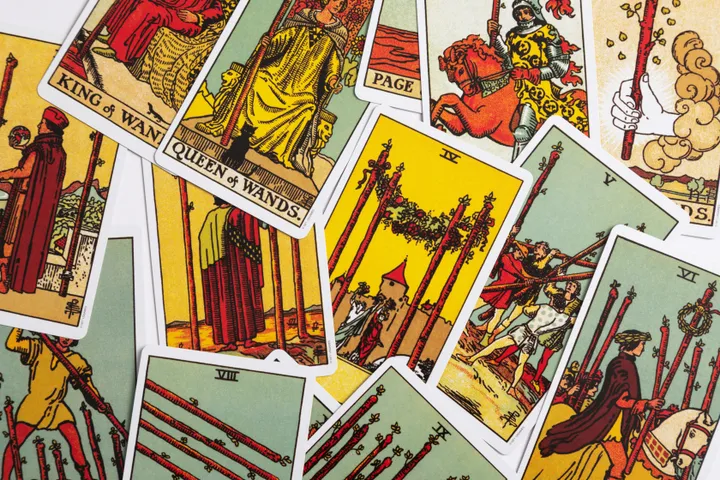Shadows & Light: Using Tarot for Self-Discovery and Shadow Work

Shadows & Light: Using Tarot for Self-Discovery and Shadow Work
We’ve journeyed through the rich history, esoteric connections, and numerical wisdom embedded within the Tarot. Now, as we conclude Phase Five, let’s explore one of its most profound and transformative applications: using Tarot not just for guidance, but for deep self-discovery and shadow work.
The Tarot, with its archetypal imagery and multi-layered symbolism, acts as a powerful mirror to the psyche. It can illuminate not only our conscious thoughts and aspirations but also the hidden, unacknowledged parts of ourselves – our “shadows.”
What is Shadow Work?
The concept of the “shadow” was popularized by Swiss psychiatrist Carl Jung. It refers to the unconscious aspects of the personality that the conscious ego does not identify with. These can be:
- Negative aspects: Traits we deem undesirable (e.g., anger, jealousy, selfishness) that we suppress or deny.
- Positive aspects: Qualities we admire but haven’t fully embodied or believe we don’t possess (e.g., power, creativity, confidence).
Shadow work is the process of bringing these unconscious elements into conscious awareness. It’s about acknowledging, understanding, and eventually integrating these disowned parts of ourselves. This isn’t about getting rid of the shadow, but about making it conscious so it no longer controls us from the depths of the unconscious. When integrated, these energies can become sources of strength, creativity, and wholeness.
Why Tarot is an Ideal Tool for Shadow Work
Tarot is exceptionally suited for shadow work for several reasons:
- Archetypal Language: The Major Arcana, in particular, embodies universal archetypes that resonate deeply with the collective unconscious, making it easier to identify and understand personal manifestations of these energies.
- Symbolic Bridging: Tarot cards speak in symbols, which is the language of the unconscious. They bypass our logical defenses, allowing insights to surface that might otherwise remain hidden.
- Non-Judgmental Reflection: The cards present information without judgment. They simply are. This helps us approach potentially uncomfortable truths about ourselves with less fear and more curiosity.
- Safe Exploration: A Tarot spread provides a structured and contained way to explore challenging themes. You can look at difficult cards in the context of the spread, making them less overwhelming.
- Illuminating the Unseen: Often, the cards reveal patterns, fears, or motivations that we were previously unaware of, bringing them into the light for examination.
Using Tarot for Self-Discovery and Shadow Work: Practical Approaches
Here are ways to incorporate Tarot into your shadow work journey:
- Dedicated Shadow Work Spreads: Many specific Tarot spreads are designed for shadow work. Look for spreads with positions like:
- “My Current Shadow”
- “What My Shadow Needs Me to See”
- “How to Integrate This Shadow Aspect”
- “Hidden Strengths in My Shadow”
- “The Root of My Limiting Belief”
- Exploring Challenging Cards:
- The Devil (XV): This card is a quintessential shadow card, representing our attachments, addictions, limiting beliefs, and material obsessions. Meditate on it. What does it reveal about your own perceived bondages?
- The Tower (XVI): While disruptive, the Tower can reveal the false structures (beliefs, relationships, habits) that need to be torn down for authentic growth. What needs to collapse in your life for you to be free?
- Swords Suit (especially 5, 8, 9, 10): These often depict mental anguish, self-imposed limitations, and difficult truths. They can point to negative thought patterns, self-sabotage, or fears that need to be confronted.
- Reversed Cards: As discussed earlier, reversed cards often indicate blocked, denied, or excessive energies – prime territory for shadow work. What aspects of this card’s energy are you resisting or overdoing?
- The Fool’s Journey as a Shadow Map: The entire Major Arcana can be viewed as a journey through the psyche. Each card presents archetypal challenges and opportunities for integration.
- Example: If you constantly attract the same type of challenging relationship, pull a card asking: “What shadow aspect of myself is being reflected in this recurring pattern?” or “What unacknowledged part of me is contributing to this situation?”
- Journaling with Cards: After drawing a card for shadow work, journal extensively.
- What emotions does it evoke?
- What uncomfortable truths does it suggest?
- How does it relate to your fears, insecurities, or even unexpressed desires?
- What would it mean to “own” the energy of this card, even its difficult aspects?
- Mirroring Practice: If a particular person or situation triggers strong negative emotions in you, consider what qualities in them might be a reflection of a disowned part of yourself (positive or negative). Draw a card asking: “What aspect of my shadow is being mirrored to me through [person/situation]?”
Approaching Shadow Work with Compassion
Shadow work is not about self-criticism or wallowing in negativity. It’s about conscious awareness and compassionate integration.
- Be Gentle with Yourself: This work can be uncomfortable. Approach it with self-compassion and patience.
- No Quick Fixes: Shadow work is a continuous process, not a one-time event.
- Seek Support if Needed: For deep-seated issues, consider working with a therapist or a trusted guide alongside your Tarot practice.
By courageously engaging with your shadows through the wisdom of the Tarot, you embark on a profound journey of healing, integration, and true self-actualization. You transform hidden fears into acknowledged strengths, bringing more authenticity and wholeness to your life.
You have now completed Phase Five: Beyond the Surface – Tarot’s Deeper Culture and Applications! This phase covered:
- Tracing the Threads: A Deep Dive into the Mysterious Origins and Evolution of Tarot.
- The Golden Dawn & Beyond: The Esoteric Lineages That Shaped Modern Tarot.
- The Tree of Life & the Cards: Exploring the Kabbalistic Connections in Tarot.
- Celestial Echoes: Understanding the Astrological Associations within Tarot.
- The Language of Numbers: Tarot & Numerology – Decoding the Numerical Significance of Each Card.
- Shadows & Light: Using Tarot for Self-Discovery and Shadow Work.